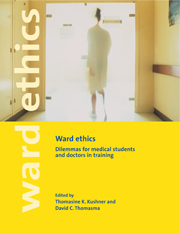Book contents
- Frontmatter
- Contents
- Acknowledgments
- List of contributors
- Prologue. Breaking the silence
- Letter from a young doctor
- Part I On caring for patients
- Section 2 Problems in truth-telling
- Section 3 Setting boundaries
- Part II On becoming a “team player”: searching for esprit de corps and conflicts of socialization
- Section 5 Argot, jargon, and questionable humor: assuming the mantle at the patient's expense
- 15 Comedians: mordant humor and cynicism
- 16 What's in a name? Derogatory references
- Section 6 Making waves: questioning authority and the status quo
- Section 7 Perceiving misconduct and whistle-blowing: observing peers or superiors commit an act deemed unethical
- Epilogue: Using this book
- Glossary
- Index
16 - What's in a name? Derogatory references
Published online by Cambridge University Press: 05 February 2015
- Frontmatter
- Contents
- Acknowledgments
- List of contributors
- Prologue. Breaking the silence
- Letter from a young doctor
- Part I On caring for patients
- Section 2 Problems in truth-telling
- Section 3 Setting boundaries
- Part II On becoming a “team player”: searching for esprit de corps and conflicts of socialization
- Section 5 Argot, jargon, and questionable humor: assuming the mantle at the patient's expense
- 15 Comedians: mordant humor and cynicism
- 16 What's in a name? Derogatory references
- Section 6 Making waves: questioning authority and the status quo
- Section 7 Perceiving misconduct and whistle-blowing: observing peers or superiors commit an act deemed unethical
- Epilogue: Using this book
- Glossary
- Index
Summary
CASE
“Goombah”
As a medical student on the wards one of the things that startled me quite a bit was the amount of questionable humor that surrounds interactions between physicians. I admit that I also find the use of certain “nonclinical” terms funny; although sometimes I wonder if I would laugh as hard under different circumstances. For instance, referring to a mass on an X-ray or a growth subcutaneously as a “goombah” occurs fairly frequently. When describing a case to the floor consultant I have heard phrases, and repeated them myself, such as “This is a 34-year-old white male with a big ol'goombah on the left side of his neck.” I then proceed to describe the mass and the location in more detail. It sets the tone of the interaction as one of both interesting pathophysiology and some degree of lightheartedness. Would the patient take offense at my description? Would he care? What if he were an inpatient and we were standing outside his room and he could overhear us discussing his case?
I am reminded of the time an 83-year-old woman was admitted with a basal cell cancer that had eroded through her nose. It was such a sight that many physicians on the floor (on other inpatient teams and from other consult services) were alerted to the severity of her mass and the rarity of the physical diagnosis opportunity.
- Type
- Chapter
- Information
- Ward EthicsDilemmas for Medical Students and Doctors in Training, pp. 163 - 170Publisher: Cambridge University PressPrint publication year: 2001

